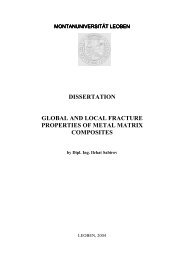Effect of Large Shear Deformation on Rail Steels and Pure Metals
Effect of Large Shear Deformation on Rail Steels and Pure Metals
Effect of Large Shear Deformation on Rail Steels and Pure Metals
You also want an ePaper? Increase the reach of your titles
YUMPU automatically turns print PDFs into web optimized ePapers that Google loves.
3<br />
3 Results <strong>and</strong> Discussi<strong>on</strong><br />
Figure 3.9: TEM bright field micrographs <str<strong>on</strong>g>of</str<strong>on</strong>g> (a) initial microstructure <str<strong>on</strong>g>of</str<strong>on</strong>g> 900A, (b) HPT deformed 900A, ɛeq = 8<br />
<strong>and</strong> (c) HPT deformed HSH, ɛeq = 8.<br />
Figure 3.10: TEM micrographs <str<strong>on</strong>g>of</str<strong>on</strong>g> (a)HPT deformed HSH, ɛeq = 2, bright field (b) corresp<strong>on</strong>ding dark field<br />
image <strong>and</strong> (c)HPT deformed HSH, ɛeq = 8, dark field.<br />
ford 52, 53 investigated the microstructural evoluti<strong>on</strong> in wire drawing <str<strong>on</strong>g>of</str<strong>on</strong>g> pearlitic steels <strong>and</strong> the<br />
resulting changes in strength. The results presented in these papers are very similar to the<br />
present findings. Also in wire drawing an intensive alignment <str<strong>on</strong>g>of</str<strong>on</strong>g> the lamellae in the drawing<br />
directi<strong>on</strong> is observed. The main mechanism for the increase in strength was found to be the<br />
decreasing lamellae distance, this was c<strong>on</strong>firmed by many studies, see for instance. 54, 55 Later<br />
investigati<strong>on</strong>s 56–60 revealed that also in drawn pearlitic wires dissoluti<strong>on</strong> <str<strong>on</strong>g>of</str<strong>on</strong>g> cementite can be<br />
observed. Two reas<strong>on</strong>s for this dissoluti<strong>on</strong> are discussed in the literature: Firstly, it is assumed<br />
that the binding energy <str<strong>on</strong>g>of</str<strong>on</strong>g> carb<strong>on</strong> atom to a dislocati<strong>on</strong> is larger than the binding energy <str<strong>on</strong>g>of</str<strong>on</strong>g><br />
the carb<strong>on</strong> in the carbide. Therefore, carb<strong>on</strong> atoms are dragged out <str<strong>on</strong>g>of</str<strong>on</strong>g> the carbide by crossing<br />
dislocati<strong>on</strong>s. Sec<strong>on</strong>dly, it is assumed that the very fine carbides resulting from this deformati<strong>on</strong><br />
become thermodynamical unstable due to the Gibbs Thoms<strong>on</strong> effect. A comprehensive<br />
discussi<strong>on</strong> about the different mechanisms is given by Gavriljuk. 61 There is even less agree-<br />
20
















